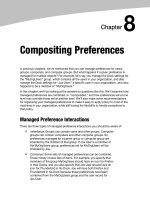Chap3 preferences
Bạn đang xem bản rút gọn của tài liệu. Xem và tải ngay bản đầy đủ của tài liệu tại đây (2.05 MB, 16 trang )
Chapter 3: Preferences
Morimitsu Kurino
U. of Tsukuba and VJU
Spring 2017
Mori Kurino (U. of Tsukuba and VJU)
Chap 2: Preferences
VJU
1 / 16
3.1 Consumer Preferences
Given any two consumption bundles x = (x1 , x2 ) and y = (y1 , y2 ), the
consumers can rank them as to their desirability using preference
relations.
(y1 , y2 ): The consumer strictly prefers (x1 , x2 ) to (y1 , y2 ).
1
(x1 , x2 )
2
(x1 , x2 ) : (y1 , y2 ): The consumer is indifferent between (x1 , x2 ) and
(y1 , y2 ).
3
(x1 , x2 ) ⌫ (y1 , y2 ): The consumer weakly prefers (x1 , x2 ) to (y1 , y2 ).
Or she has (x1 , x2 ) at least as good as (y1 , y2 ).
These are related “relations”:
x ⌫ y and y ⌫ x , x : y
x ⌫ y and (not x : y ) , x
y
When we talk about the “preference relations” or “preferences,” we
usually mean the “at-least-as-good-as” relation. Other relations can be
derived from it.
Mori Kurino (U. of Tsukuba and VJU)
Chap 2: Preferences
VJU
2 / 16
3.2 Assumptions about Preferences
1
2
3
Completeness.
It is always possible to rank-order any two bundles x and y by
preference.
Thus, we have either x ⌫ y or y ⌫ x.
Reflexivity.
Any bundle is at least as good as itself.
x ⌫ x.
Transitivity.
If x is at least as good as y and y is at least as good as z, then x is at
least as good as z.
x ⌫ y and y ⌫ z ) x ⌫ z.
Mori Kurino (U. of Tsukuba and VJU)
Chap 2: Preferences
VJU
3 / 16
ndifference Curves
3.3 Indifference Curves (1)
It isItconvenient
to to
describe
preferences
is convenient
describe
preferencesgraphically
graphicallyusing
using aa
construction
known
as
indifference
curves.
construction known as indifference curves.
An indifference
curve) of
of bundles
bundlesthat
thatare
are
An indifferencecurve
curveisis the
the set
set (or curve)
indifferent
to
each
other.
indifferent to each other.
Indifference
curve
Indifference
curve
at at
(x1(x
, x12, )x2 ):
¨Kurino“Micro
Utku
Theory”
MoriUnver
(U. of
Tsukuba(BC)
and VJU)
Preferences
Chap
2: Preferences
VJU
74 // 20
16
ndifference Curves-2
3.3 Indifference Curves (2)
z
z
y
y
x
z.
Mori Kurino (U. of Tsukuba and VJU)
Chap 2: Preferences
VJU
5 / 16
3.3 Indifference Curves (3)
Claim
Indifference curves of a single consumer cannot intersect each other.
Indifference Curves-3
Why?
Indifference curves of a single consumer cannot intersect each other.
Proof. Why?
Suppose for a contradiction that they did.
Suppose they did:
x
y x
z but y
z; contradicting transitivity of
¨ : “Micro
M. Utku
Theory”not
(BC) (y : z);
Preferences
9 / 20
x : y and
xUnver
z but
contradicting the transitivity
of :.
Mori Kurino (U. of Tsukuba and VJU)
Chap 2: Preferences
VJU
6 / 16
3.4 Examples of Preferences (1): Perfect Substitutes
Examples of Preferences
Perfect Substitutes: The consumer is willing to substitute one good
for Perfect
anotherSubstitutes:
at a constant
Therate.
consumers are willing to substitute one
for another
constant rate.
Thegood
simplest
case at
is aone-to-one
basis.
The simplest case is one to one basis.
The indifference curves have constant slopes and moreover they all
have the same
slope.
The indifference
curves
have constant slopes and moreover they all have
The
slope
does
not need to be -1, that is: these items need not be
the same slope.
substituted at one-to-one basis!
The slope does not need to Preferences
be -1, that is, these items need 10not
be
/ 20
substituted at one-to-one basis!
¨
M. Utku Unver
“Micro Theory” (BC)
Mori Kurino (U. of Tsukuba and VJU)
Chap 2: Preferences
VJU
7 / 16
3.4 Examples of Preferences (2): Perfect Complements
Perfect Complements: Goods that are always consumed together in
Perfect Complements: Goods that are always consumed together in
fixed proportions.
fixed proportions.
For example left shoe, right shoe.
For example, left shoe and right shoe.
Indifference Curves
These proportions do not need to be one-to-one!
These proportions do not need to be one-to-one!
Mori Kurino (U. of Tsukuba and VJU)
Chap 2: Preferences
VJU
8 / 16
3.4 Examples of Preferences (3): Bads
Bads: A commodity that a consumer does not like.
Bads: A commodity that a consumer does not like.
Example: Indifference curves for One Good and One Bad.
Example indifference curves for One Good and One Bad
Mori Kurino (U. of Tsukuba and VJU)
Chap 2: Preferences
VJU
9 / 16
3.4 Examples of Preferences (4): Neutrals
Neutrals: A commodity that a consumer does not care for one way or
Neutrals: A commodity that a consumer does not care for one way
another.
or another.
Indifference curves are always like this for one Neutral and one Good.
Indifference curves are always like this for one Neutral and one Good
Mori Kurino (U. of Tsukuba and VJU)
Chap 2: Preferences
VJU
10 / 16
3.4 Examples of Preferences (5): Satiation
Satiation:
There
is an
overallbest
bestbundle
bundlefor
forthe
the consumer
consumer and
and the
Satiation:
There
is an
overall
the
closer
he
is
to
the
best
bundle,
the
better
off
he
is.
closer he is to the best bundle, the better off he is.
Example:
Example:
Mori Kurino (U. of Tsukuba and VJU)
Chap 2: Preferences
VJU
11 / 16
3.5 Well-Behaved Preferences (1): Monotonicity
In general it will be convenient to focus on a few general shapes of
indifference curves.
We will often assume that more is better (so we will be talking about
goods rather than bads).
Definition (Monotonic Preferences)
If x = (x1 , x2 ) and y = (y1 , y2 ) are such that x1
then (x1 , x2 ) (y1 , y2 ).
Mori Kurino (U. of Tsukuba and VJU)
Chap 2: Preferences
y1 , x 2
y2 , and x 6= y ,
VJU
12 / 16
3.5 Well-Behaved Preferences (2): Monotonicity
Monotonicity implies that indifference curves are negatively sloped (or zero
sloped).
Monotonicity implies that indifference curves are negatively sloped.
Mori Kurino (U. of Tsukuba and VJU)
Chap 2: Preferences
VJU
13 / 16
3.5 Well-Behaved Preferences (3): Convex Preferences
We will often assume that averages are weakly preferred to extremes.
Example: (little food, much water) could be indifferent to (much
Convex Preferences:
food, little water). But both are worth than (some food, some water).
We will often assume that averages are weakly preferred to extremes.
Example:
(littleprefences)
food, a lot of water) could be indifferent to (a lot of
Definition
(Convex
food, little water). But both are worse than (some food, some water).
SupposeDefinition:
(x1 , x2 ) :Suppose
(y1 , y2()x and
0 <(yt, <
1. Then(0, 1). Then
1 , x2 )
1 y2 ) and t
(tx1(tx
+1 (1
+ (1 t)y
t )1y,1tx
, tx22 +
+ (1
(1 tt)y
)y2 )2 ) ⌫(x(x
12,)x2 ).
1, x
¨ of Tsukuba
Mori Kurino
(U.
and VJU)
M. Utku
Unver
“Micro Theory”
(BC)
Chap
2: Preferences
Preferences
VJU
17
/ 20
14 / 16
3.6 The Marginal Rate of Substitution
The Marginal Rate of Substitution (MRS)
The slope of an indifference curve is known as the marginal rate of
substitution
(MRS).
The slope of
an indifference curve is known as the marginal rate of
substitution
MRS
measures (MRS).
the rate at which the consumer is willing to substitute
MRS
measures
the rate at which the consumer is willing to substitute
one good for another.
one good for another.
Here xx21 is the rate at which the consumer is willing to substitute
goodx22 for good 1. The slope is negative. MRS is usually a negative
Here
x1 is the rate at which the consumer is willing to substitute
number.
good 2 for good 1. The slope
is negative. MRS is usually a 18negative
Preferences
/ 20
number.
¨
M. Utku Unver
“Micro Theory” (BC)
Mori Kurino (U. of Tsukuba and VJU)
Chap 2: Preferences
VJU
15 / 16
Properties of Preferences and MRS
1
2
Monotonic preferences ) MRS < 0.
Strictly convex preferences ) diminishing marginal rate of
substitution.
That is, as we increase x1 , the slope of the indifference curve decreases
in absolute value. This means that the amount of good 2 the person is
willing to substitute for good 1 is decreasing as you increase the
amount of good 1 consumed.
Mori Kurino (U. of Tsukuba and VJU)
Chap 2: Preferences
VJU
16 / 16









